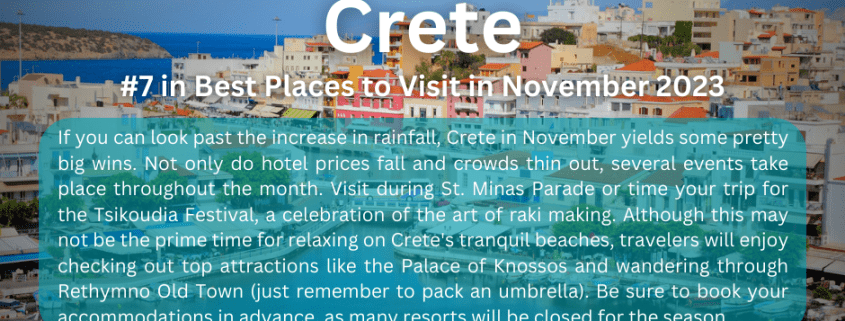Crete #7 in Best Places to Visit in November 2023
Why Go To Crete
If there was one word to describe the Greek island of Crete, it would be “diverse.” Sandy beaches hide among soaring mountains, palm tree forests grow in the middle of sprawling plains, bustling modern cities share coastlines with centuries-old structures. And speaking of cities — in Crete, they reflect the people that came before. The streets are lined with architecture mirroring the styles of the Minoans, the Venetians and the Ottomans, as well as contemporary Greeks. Despite the visible contradictions, this island maintains a sense of unity, felt whenever you step onto the street, dine at a local taverna, or enjoy a glass of raki at a sidewalk café.
Crete’s experiences are as assorted as its history, so take some time to decide what type of vacation you’re looking to have before you set anything in stone. For an urban setting with a variety of restaurants, bars and nightclubs, consider staying along the northern coast in Chania or Heraklion. Those who prefer the great outdoors should head to Rethymnon or Agios Nikolaos for the many beautiful beaches.
Best Months to Visit
The best time to visit Crete is from mid-May to June or from September to October. May brings with it warmer waters and beautiful wildflowers that can be spotted throughout the island’s natural attractions. If you plan on going during the summer, travel experts strongly suggest to take your vacation in June, as July and August usher in lots of crowds, which may compromise the comfort of visitors who traveled to the island to escape. The heat from the high season cools down in September and October, along with room rates and tourists, making this the best time to visit.
Culture & Customs
Greeks are known for their hospitality and Crete is regarded as a friendly tourist destination. However, understanding Greek etiquette will help you interact and blend in with the locals.
Understanding body language is key. Be aware of your gestures; for example, the hand signal for “OK” using the thumb and index finger, is offensive in Greece. Greeks indicate “yes” (a slight downward nod) or “no” (a slight upward nod) differently than Americans.
Because of Crete’s warm climate, shorts and T-shirts are acceptable when walking around the cities or the beaches. However, if you are planning to visit any religious sites, make sure to dress more conservatively in long pants or skirts, and shirts that cover the shoulders and the chest area. You should dress more formally when dining at restaurants as Greeks tend to get dressed up when they go out.
Cretan restaurants are used to serving foreigners and generally accept most major credit cards. However, Cretans themselves generally pay in cash (the official currency of Greece is the euro). Since the euro to U.S. dollar exchange rate fluctuates, be sure to check what the current exchange rate is before you go. Like residents of many other countries in Europe, Greeks don’t tend to tip, so you don’t have to either. Service charges are often added to restaurant bills, but if you want to give something extra, a 10 percent tip is sufficient.
Safety
Crete is renowned for its safety, however, one safety concern of note is for those who decide to rent a car. Aside from the main highway that runs through the main cities in Crete’s northern coast, the more rural mountainous areas can be a challenge for drivers, as many of those roads are underdeveloped and, in some cases, lack proper signage. Cretans strongly advise driving very carefully through these areas and asking locals for the best way to navigate
Getting Around Crete
The best way to get around Crete is via car. There are public buses that connect visitors to the major cities of Heraklion, Rethymnon, Chania and Agios Nikolaos. There are also a few lines that transport visitors to southern cities, but since all public bus timetables are subject to seasonal needs, the service may be too sporadic for those on vacation. You can rent a car in any major city as well as at Heraklion International Airport (HER) and Chania International Airport (CHQ). If you plan to do a lot of exploring, keep in mind that the island is larger than it may appear; you can avoid spending excessive amounts of time behind the wheel by planning your itinerary in advance.
Driving in Crete, however, can be challenging depending on where you are. In the major cities along the northern coast, there are usually road signs in Greek and English. However when visiting more remote areas, especially in the more rural south, travelers are likely to run into unpaved roads lacking signs. Travel experts strongly recommend driving very cautiously among mountain roads and seeking advice from locals beforehand if possible.
Car
You’ll find rental agencies in the larger cities as well as at both the Heraklion and the Chania airports. Although U.S. driver’s licenses have been known to work in the past, save yourself the worry by obtaining an International Driving Permit before you leave the states. An international driver’s license can help you avoid any miscommunication at rental agencies or if you get into a sticky situation on the road. To rent a car in Crete, drivers must be 21 years of age. You can apply for one here.
Bus
KTEL bus service offers transportation between Chania, Rethymnon, Heraklion and Agios Nikolaos. Buses also connect the major cities to smaller towns on the southern coast. Depending on the length of your trip, fares can range anywhere from €2 to €11 EUR. Service between major cities in the north is more frequent than those heading south since roads on the southern coast aren’t as developed.
On Foot and By Taxi
Once you’re in one of the major towns, you’ll find that, as far as transportation goes, your feet should suffice. However, if you find yourself growing weary or need to get somewhere fast, taxi cabs are available. Just be aware that drivers have been known to forget to turn on their meters, so you should always agree on a price before getting into the cab. Before hopping into a cab, it’s also a good idea to write down the address of your destination to avoid any confusion as multiple places in Crete tend to have the same name. It’s also common for taxi drivers to pick up hailing passengers if someone is already in their car to double up on fares. If the driver doesn’t ask ahead of time if it’s alright, then politely alert the driver if you prefer not to share the cab with other passengers.
Entry & Exit Requirements
To enter Greece, your passport must be valid through your stay and for at least three months after. You won’t need a visa, however, unless your stay exceeds 90 days. Visit the U.S. Department of State’s website for more information on entry and exit requirements.
Start Saving with iTravelDirect’s Exclusive Travel and Lifestyle Benefits Membership
CLICK HERE to Test-Drive our Guaranteed Savings
We offer a 110% Price Guarantee – Find a lower price anywhere online and we will refund you 110% of the difference.
CLICK HERE for a full list of services and Membership Discounts.
When you join iTravelDirect, you’ll have full access to all club benefits.
Your membership gives you the freedom to travel when you want, to where you want.
And you won’t find lower rates anywhere, guaranteed. So, pack your bags and start planning that vacation of a lifetime today!












Leave a Reply
Want to join the discussion?Feel free to contribute!